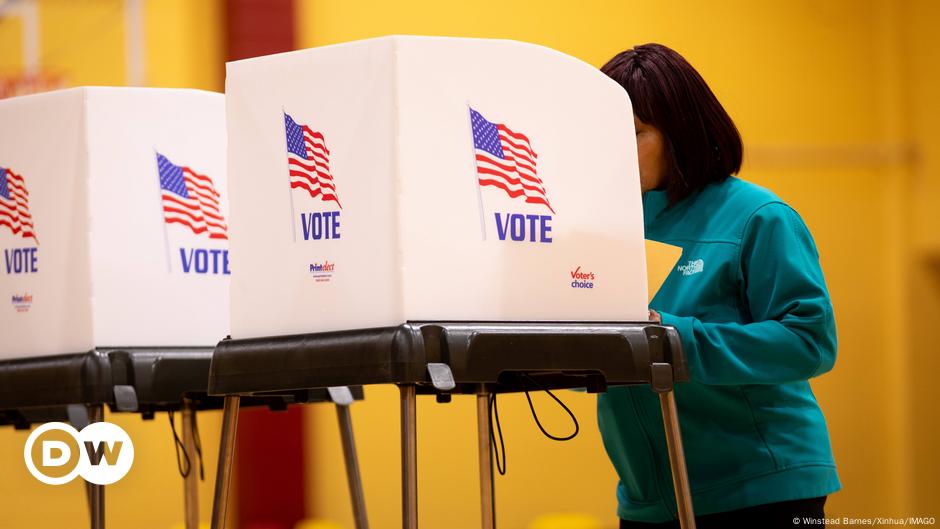Politicians say that polls conducted on election day are the only thing that matters. According to current polls for the presidential election, the race between Kamala Harris and Donald Trump is as close as ever.
In the 2020 election, the majority of pollsters correctly predicted Joe Biden's victory, but Trump's lead on Election Day was significantly smaller than in pre-election polls.
Four years ago, Trump won decisively, despite polls predicting a landslide victory for his rival, Hillary Clinton. Pew Research later found that at least 88 percent of national polls overestimated the popularity of the Democratic nominee.
“National opinion polls can easily be misleading when you try to generalize about what will happen,” Thomas Gift, head of the Center for American Politics at University College London, UK, told DW. “For example, right now Kamala Harris looks like she's going to win the most votes, she's leading by a few percentage points. But it's not clear if she's going to win more voters.”
At this point, pollsters see voters leaning equally toward Harris and Trump, respectively. But are their predictions right this time? It all depends on whether pollsters can track down “hidden” Trump voters.
The Art and Science of Election Voting
When determining voter intentions, pollsters try to take into account as many variables as possible.
“We capture very diverse people and share that information with the public,” says Don Levy, director of the Siena College Research Institute, which, along with the New York Times, conducts one of America's most respected polls.
Polling companies typically attempt to randomly survey a sufficient number of “voters” with a 95 percent confidence level and a certain margin of error, often three to four percent.
The sample size required to meet these parameters is small. A poll needs only 600 people to represent 100,000 people with a margin of error of four percent. To achieve a three percent margin of error, 1,000 people must be surveyed. So much for the science behind election polls.
The trick is to find the right representative mix for the sample to ensure the survey is as accurate as possible. Each pollster follows his own methods.
First, it must be determined whether or not someone can vote. If more than half of the eligible electors vote, there is no point in voting for a non-voter.
To do this, Sienna combines a person's electoral participation records with oral surveys over the phone. If a person is identified by Siena as a potential voter, they are surveyed about their opinion of the election and assigned to a demographic category. It is used to create quotas for surveys because the more detailed the voter samples, the more reliable the results of the survey.
Siena uses about 40 quotas, which are intended to reflect the voting population as accurately as possible. This includes gender, age, education level, ethnicity and more.
“We try really hard to cite these models, not just for the entire United States or the entire state of Pennsylvania, but for individual parts of the state,” Levy explains.
Find the hidden Trump voter
Finding representative samples with 40 different allocations is not easy. Due to flaws in the survey methods in 2016 and 2020, Trump's popularity was significantly underestimated.
Levy attributes the discrepancy between polls and actual election results to pollsters struggling to capture a specific demographic: voters who support Trump and don't want to participate in polls.
“The same error has crept into every opinion research firm,” he says of this distortion of results. He believes that insufficient registration of these anti-establishment voters who refuse to participate in the polls has led to an error of between three and seven percent in 2020 alone. The solution? To count these naysayers.
“This is Don from the Siena College Research Institute, and we're doing a survey today,” I said, and quite a few of the invitees responded simply.Trump' and disconnected,” Levy reports. “We recorded it in 2020, but didn't count them. In retrospect, we realized that if we had done so, our margin of error would have been revised by about 40 percent. So let's count them this time.”
Polls, predictions and Pennsylvania
Unlike other countries, elections in the United States are not won by the candidate who receives the most votes from the electorate. Instead, the future head of state must win the votes of at least 270 of the 538 electors.
Each state has a certain number of electors, which depends on the number of members of Congress. A state's electors are usually awarded to the candidate who receives the most votes in that state. Except in Maine and Nebraska, one candidate receives all of the state's electoral college votes.
This complex electoral system has been used in the past by Trump in 2016 and George W. Bush in 2000. Bush won despite receiving fewer votes than both of their rivals.
So, to make predictions about how the Electoral College will be split, analysts and commentators must look at polling data about the winners of each state and use it to create maps showing red, blue and undecided states.
At this point, most analysts agree that the presidential election will be decided in seven states: Arizona, Georgia, Michigan, Pennsylvania, Nevada, North Carolina and Wisconsin.
Although predictions are not 100% reliable, many analysts are focusing on one state in particular in this head-to-head race: Pennsylvania. In the last four elections, the state has sided with the president-elect and has 19 electoral votes.
“It's hard to imagine candidates winning the White House without winning Pennsylvania,” says Thomas Gift of University College London, who hails from Pennsylvania.
Gift says the amount of money both sides are spending and the attention paid to the Keystone State is a sign of its importance. “The candidates are doing everything they can to win Pennsylvania. I believe this is where the election will be decided.”
Adapted from English by Phoenix Hanzo.

“Amateur coffee fan. Travel guru. Subtly charming zombie maven. Incurable reader. Web fanatic.”







More Stories
Martin Schulz: “I want more courage for the United States of Europe”
US reports first case of H5N1 bird flu virus in pigs
Polestar fears US sales ban